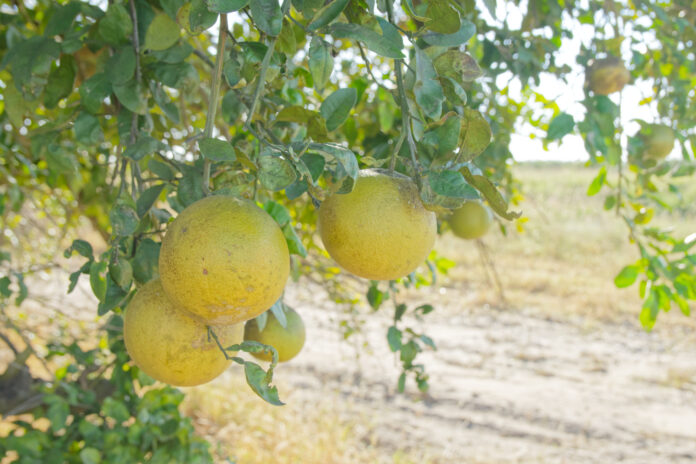A flood of Mexican grapefruit is plugging the gap on store shelves here to make up the shortfall caused by the great freeze of February.
But that incoming fruit from across the border has a problem: A stealth rule change by the U.S. Department of Agriculture is letting it cross without undergoing its usual inspection and substandard grapefruit is pouring into the United States.
The USDA’s order, called Patch No. 065, suspended border inspections of Mexican grapefruit when it was issued in April and, by using an administrative order, bypassed the normal rule-making process which would require a public comment period.
Patch No. 065 ordered USDA inspectors not to use juice content as a measure of maturity, a long-time test to determine grapefruit quality.
“Our industry has never not had a situation where we weren’t at least asked about the consequences of something, whether it’s through the Federal Register or simple calls to the industry to say, ‘Hey look, this is what we’re considering,’” said Dale Murden, president of Texas Citrus Mutual.
“Nothing on this,” he added. “Quite frankly, we accidentally found out about it.”
Lowering the bar
The Texas commercial fresh market grapefruit has an annual value of $184.2 million, all of it from production in the Lower Rio Grande Valley, with Hidalgo County accounting for about 85 percent. Among citrus-producing states, Texas ranks third behind Florida and California.
The USDA may not be measuring juice content of Mexican grapefruit, but the Texas Cooperative Inspection Program, which lacks any enforcement authority, continues to make those inspections as required by state law.
Here’s what the inspectors found.
“Mexican grapefruit imports from January to November have increased by 99.7 percent year-over-year,” wrote Luis A. Ribera, a professor and AgriLife extension economist in the Department of Agricultural Economics at Texas A&M University, along with his colleagues Landyn Young and Dan Hanselka.
“The Texas Cooperative Inspection Program (TCIP) reported 51 loads of grapefruit crossing from Mexico to Texas between Sept. 1, 2021, and Oct. 28, 2021,” the report continued. “Based on TCIP inspection reports, if the juice content requirement for maturity determination had not been suspended, 149 out of 174 lots out of those 51 loads would have failed quality standards and been rejected. In other words, 85.6 percent of the tested lots would have previously been rejected for sale to American consumers.”
The United States exports fresh grapefruit worldwide and is the fifth-largest producer. Yet the country also imports grapefruit, almost all of it from Mexico, South Africa, Israel, Peru and Chile.
But the February freeze cost Texas citrus growers about 70 percent of their crop, opening the door for Mexican fruit unaffected by the cold weather.
The A&M report concluded the Texas fresh grapefruit industry could experience economic losses of up to $70.5 million annually due to the suspension of the juice content requirement and more than 1,000 Texans could lose their jobs.
“If it’s allowed to continue, and cheap imports come in uninspected for quality like I have to do, this really could be an industry-killer,” Murden said. “ … And I’m not anti-trade at all, but if I’ve got to uphold the quality, why shouldn’t they?”
Across state lines
Citrus-producing states are sounding the alarm.
“The relaxation in standards of maturity for imported grapefruits has given Mexican grapefruit producers a distinct and unfair advantage over Texas producers, which will lead to dumping of inferior fruit in our state and across the country,” wrote Texas Agriculture Commissioner Sid Miller in a letter to USDA Secretary Tom Vilsack last month.
Miller also warned selling substandard Mexican fruit would damage the reputation of Texas-produced citrus.
“USDA cannot continue to endorse the overshadowing of high-quality Texas grapefruit by excessive imports of inferior-quality grapefruits,” Miller continued. “I strongly urge the USDA to immediately reinstate the juice content requirement for imported grapefruit maturity determinations.”
Florida Commissioner of Agriculture Nikki Fried also wrote to Vilsack, demanding the reinstatement of inspections.
“This deeply troubling action is creating further unfair advantages for Mexico and for others over our domestic industry, which is already facing challenges when it comes to citrus greening as well as loss of access to foreign markets due to supply chain issues causing backlogs at U.S. ports,” Fried wrote.
The USDA did not respond to an email seeking comment for this story.
Buyer beware
The Texas citrus industry has spent significant amounts of money over the years marketing its grapefruit.
Now growers are worried it may all have been for nothing.
“You go to the store and you grab that grapefruit and you take it home and it doesn’t have any juice or it’s tasteless or it has just failed all kinds of quality, you’re never going to buy that product again,” Murden said. “It’s a grapefruit, and consumers don’t really care diddly-damn where it came from, unfortunately. That whole ‘Buy USA’ thing sounds great, but what consumer do you know really looks at that?”
The deep freeze of February saw temperatures drop into the low 20s, resulting in severe losses of fruit, blossoms and even trees in Texas citrus groves. Similar major freezes occurred in 1983 and 1989.
“Battling back from a freeze is one thing,” Murden said. “Battling back from a freeze and your own government, that’s a bigger problem to me.”




